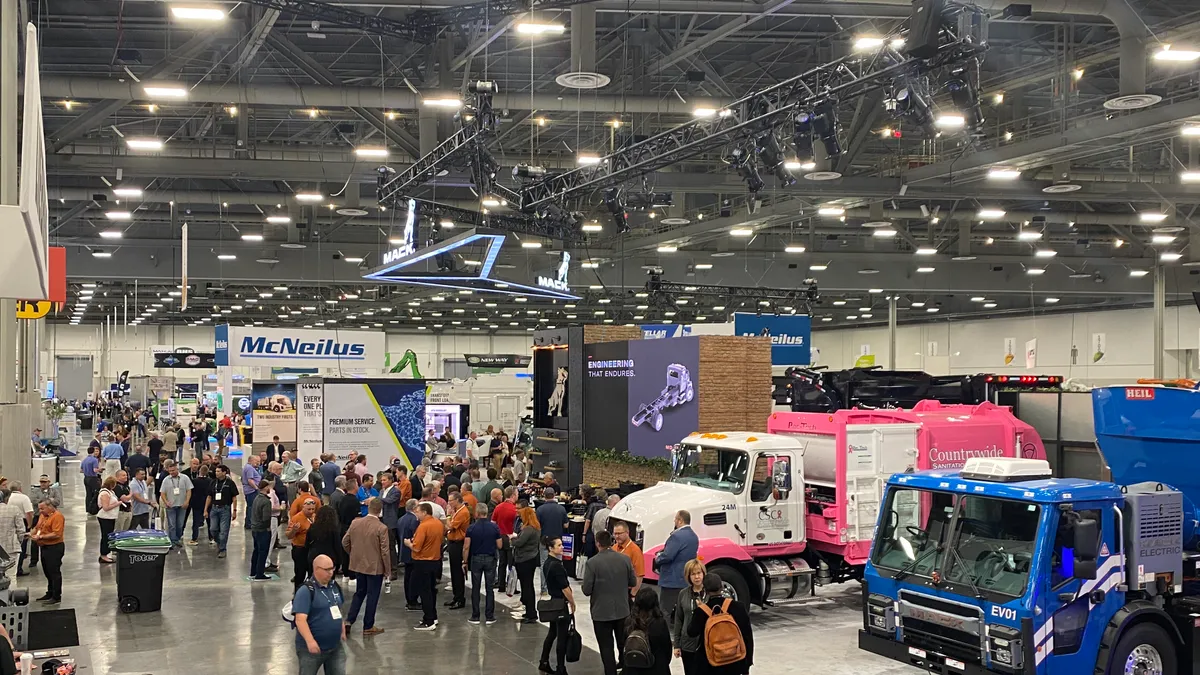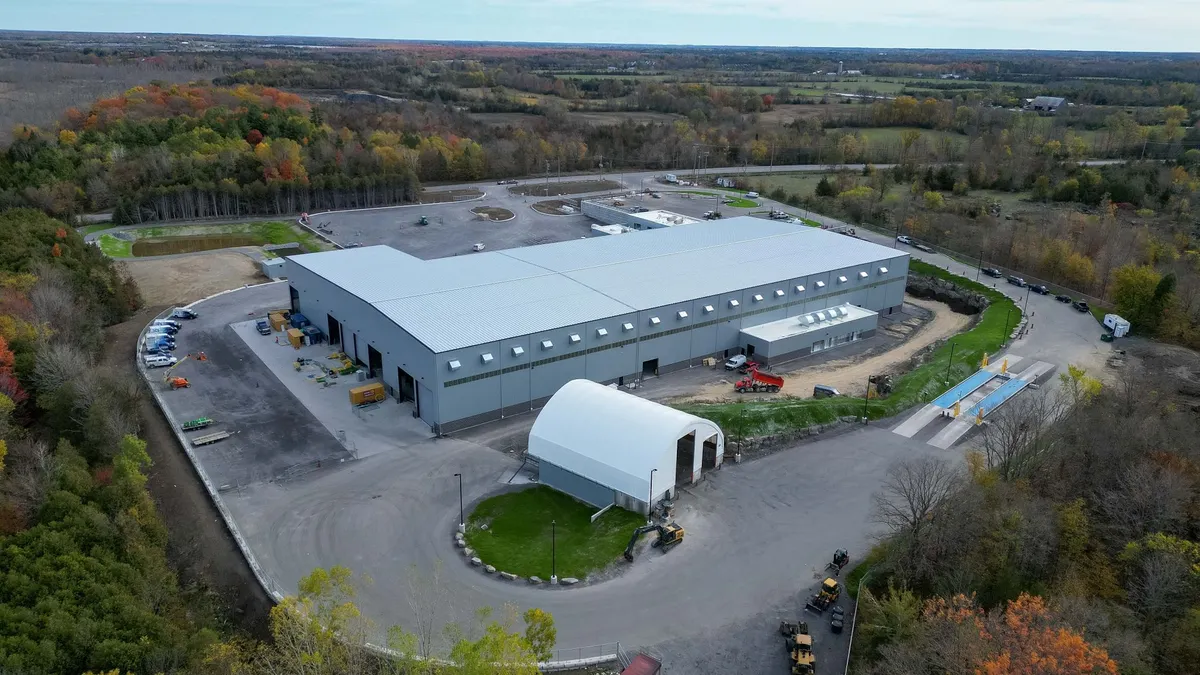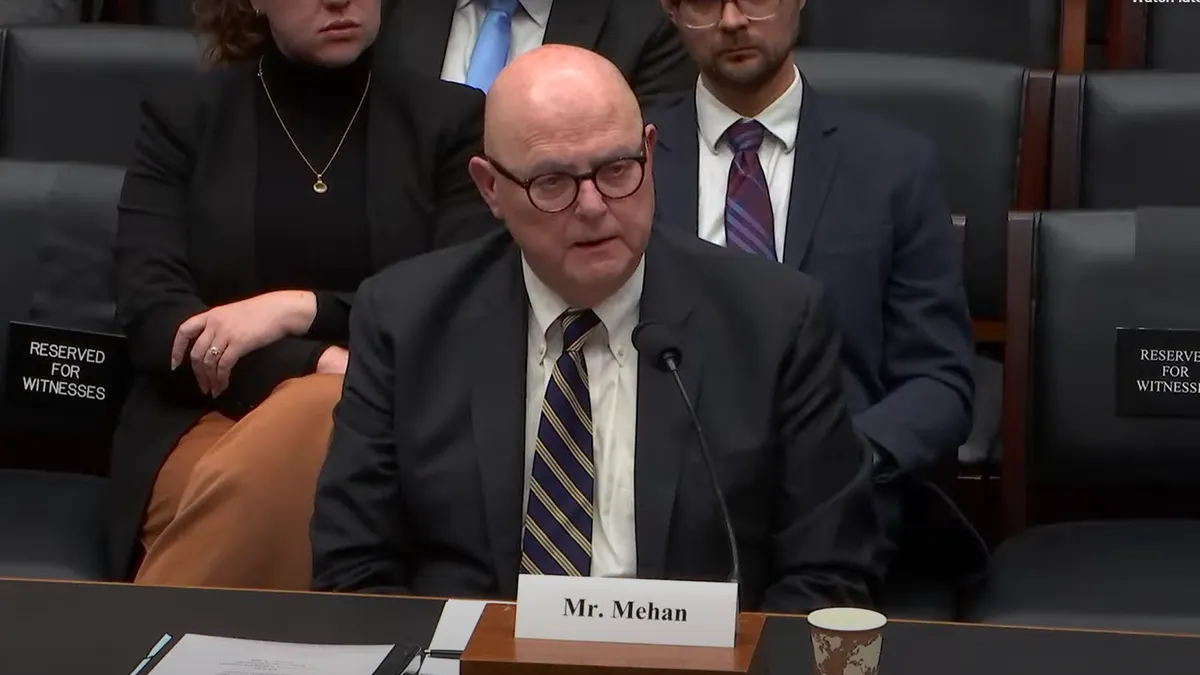Choosing alternative fueling options for heavy-duty vehicles has become quite complex, due in part to a patchwork of overlapping regulations. WasteExpo 2024 showed that the industry can expect to see an increasing number of choices, as well as a split among certain major companies in terms of their investment plans.
While compressed natural gas remains the industry’s most popular alternative to diesel, battery electric vehicles also featured prominently at the event. The show also saw the debut of a hydrogen fuel cell truck. These newer options are still considered to be in their earlier stages.
Discussions throughout the conference’s investor summit and other sessions centered around common themes such as range, cost and availability of charging or fueling infrastructure. Such discussions aren’t new at WasteExpo, and last year’s event featured plenty of opinions about zero-emission vehicle production and usage requirements under California rules. These requirements will ultimately require waste companies to use zero-emission vehicles by 2042, with multiple other states also moving toward requirements on varied timelines.
This year’s event happened in the wake of the U.S. EPA finalizing its own rules requiring manufacturers of heavy-duty fleets to reduce emissions in new models starting in 2027 and continually improve on those reductions by 2032. The enforcement timing of these rules may be affected by multiple lawsuits, but original equipment manufacturers and waste companies said they’re moving ahead anyway.
Volvo’s Mack Trucks, for example, has a target to sell 35% zero-emission vehicles by 2030. Jonathan Randall, president of Mack Trucks North America, said his company’s new and upcoming diesel engines are “incredibly clean,” but the future appears to be in EVs. More than 50 authorized Mack dealers have already been certified to work on electric vehicles, with more coming, and Peterbilt is seeing a similar trend driven by regulatory requirements.
“It’s not just a California thing. There's five more states in 2025, there's more states in 2026 and then in 2027 electric vehicles are gonna be a reality for all 50 states,”said Jason Skoog, general manager at Peterbilt and vice president of PACCAR. “So every one of our dealers sees it ... and they're not gonna miss out."
Figuring out the right application in each market may be complicated, leading many speakers to say it won’t be a one-size-fits all approach. Recology, which has reported notable strides in reducing its own fleet emissions, advised others to keep an open mind and be patient as technology evolves.

"The real goal is to be able to line up any of the alternate fuel types that may be available ... and have that perform just like any other diesel truck,” said Jim Mendoza, the company’s director of equipment procurement and maintenance. "We'd love to see that same performance out of a diesel vehicle as you would with electric or CNG or hydrogen, but there's going to be a little give and take here.”
Scaling battery electric vehicles
Battery electric vehicles are gaining broad popularity, as shown in the 2024 State of Sustainable Fleets report shared this week at the ACT Expo. It noted that orders for electric buses, trucks and vans doubled between 2022 and 2023. But usage for heavy-duty refuse applications is still in the earlier stages.
James Johnson, president of Autocar, said it has taken a long time to perfect CNG and he doesn’t think EVs are there yet for waste applications. His company built a hydraulic hybrid nearly 20 years ago, but it was expensive and had limited capabilities, and he feels current versions are still more for show.
"We have the tendency to call them parade trucks ... because that's really what they've been doing, parading around,” he said, citing questions about infrastructure and maintenance.
Mack had a different view, noting multiple customers were currently running EVs around the country.
"We're beyond the, ‘I'm buying this for a PR play,’” said Randall. “Fleets are now recognizing that this is coming and they need to figure out how it's going to work for their operation.”
Aside from cost, one of the biggest themes that came up throughout the event was how range compares between EVs and diesel or CNG vehicles.
“Range anxiety is one of the biggest challenges ... and I use that word ‘anxiety’ because it truly is that way,” said Kelleigh Ash, chief technology officer for Battle Motors. “Obviously it depends on the use case, but in most instances one of our smaller battery pack sizes will absolutely meet that range and so one of the challenges is proving that.”
Battle, which has grown since acquiring Crane Carrier in 2021, offers multiple battery pack sizes and has a patented enclosure system which Ash said can help handle unique weight distribution challenges. The company also manufactures CNG and diesel vehicles, but sees big growth opportunities in EVs.
Ash said some customers adjust their operating schedules to account for charging time, in some cases moving to staggered shifts of eight to 10 hours to allow for an estimated four-hour charging window. This landscape will continue to evolve as battery technology changes “rapidly,” she said, with incrementally more powerful versions expected to hit the market in the next few years.
Randall said that for many customers the goal is to be able to run a full route in 10 hours on one charge, which for some could entail 125 miles and 1,200 pickups, but for the most part “we’re not there yet.” He said there are cases where there this is happening, but it all depends on the use case. For example, urban markets with denser and shorter routes will likely be a better fit to start.
“When you look at battery electric, you can't just look at it in terms of buying a truck or buying an asset. You've got to look at it in terms of the entire ecosystem and everything that goes with it,” he said. “You got to understand the routes and which routes make the most sense.”
WM CEO Jim Fish cited range and weight as key barriers to his company making any significant investment in EVs beyond small-scale pilots, also citing the 125-mile threshold.
“I'm not opposed to electric in any way, shape, or form, but we don't have the infrastructure at this point and we don't have a viable vehicle for us,” he said.
Republic Services, on the other hand, is betting big on EVs. The company currently has 15 vehicles on the road and expects to reach 50 by the end of the year.
"The trucks that we have running right now we're really confident that we're going to be buying at scale,” said CEO Jon Vander Ark. He said the company made “mistakes” along the way as part of being an early mover in the space, but now understands “it’s not a truck, it’s a system” and is prepared to move at scale. Earlier this month, certain area presidents and local leaders attended a demo in Phoenix to learn more about the vehicles.
“This year alone, we're going to invest $100 million between EV trucks and infrastructure,” said CFO Brian DelGhiaccio. “You can imagine the upside when you start thinking about growth, as we realize those benefits in lower energy costs and reduced maintenance costs.”
A dedicated team has been pursuing local, state and federal incentives for multiple years to help offset costs. They’ve also mapped out how factors such as topography, weather and distance will affect charging and performance needs for all of the company’s routes.
“Over 90% of the utilities we've gone to to claim power we've gotten it, and the early bird gets the worm in those cases,” said Vander Ark.
Waste Connections CEO Ron Mittelstaedt said his company was piloting EV vehicles in three markets, with better use cases in areas that require less driving such as New York City. He said the trucks are “not quite ready for prime time yet,” citing similar factors about range and limited charging infrastructure.
“EV will get there, but it's not around the corner,” he said. When asked to predict where the industry would be in 15 years, Mittelstaedt estimated that a “large percentage” of the fleet could be some combination of electric, hybrid or hydrogen.

High hopes for hydrogen
Recology said it’s heartened by the improvements in EV technology, but also has its sights set on other possibilities.
"The performance of the battery electric has drastically changed from where it was just a few years ago,” said Mendoza, adding that “we're very excited to see what happens with the hydrogen fuel cell."
During the event, New Way and Hyzon debuted what they say is North America’s first electric refuse truck powered by hydrogen fuel cells. Recology will demo the truck, which Hyzon anticipates could be commercially available in late 2025.
"Our biggest advantage is power density. We have the most power dense fuel cell available,” said Steven Boyer, vice president of commercial at Hyzon.
Boyer said hydrogen fuel cell-powered vehicles have lower weight than electric, perform well in cold weather, refuel in a similar amount of time as diesel and have a longer operating range, and offer a similar user experience to CNG. He noted that the federal government plans to invest billions in hydrogen fueling hubs around the country, with similar networks also growing in Canada and California. Pilots are also underway to create hydrogen from landfill gas, through companies such as Hyzon’s partner Raven SR, but the infrastructure is still nascent.
“Right now, hydrogen is expensive,” said Boyer, citing prices of around $30 to $34 per kilogram at certain stations in California. He anticipates that could drop to around $15 per kilogram by the end of the year, making it more comparable to diesel, and said further decreases will help offset the total cost of ownership.
“When we get to ‘26 and ‘27, we expect to see hydrogen prices in the single digits. And when we get to the single digits that's when the TCO becomes equal to what we see right now,” he said.
Boyer also said that fleets currently using CNG would have a similar maintenance experience with hydrogen after making certain updates such as adding hydrogen sensors. He also cited existing tests on the road, including with Performance Food Group in California.

CNG still growing
In the meantime, CNG remains a popular option. The Sustainable Fleets report noted that refuse vehicles led new orders for the category in 2023, accounting for 33% of all Class-8 purchases, and the sector is expected to resist a broader decline in popularity for this option.
“Use of natural gas in refuse and goods movement sectors is likely to persist thanks to their strong fit and performance in services that are otherwise challenging to electrify,” said the report.
WM runs an estimated 61% of its collection fleet on CNG and plans to expand that. Waste Connections said it’s currently around 25% and may see nominal increases. GFL Environmental is now around 18% and plans to reach 50%; but like others, the company doesn’t view rural markets as being cost-effective to convert.
Hexagon Agility, a company that makes CNG tanks for vehicles — including in the refuse market — said this market has grown over many decades and has further runway ahead.
“We still see a long bridge for CNG, natural gas in general,” said Craig Kerkman, market segment manager for refuse. “We don't see it going away any time soon."
Kerkman said the capability to project stable CNG fuel costs is a “big deal” for fleet operators, with the potential to see pricing below retail if waste companies have fueling infrastructure on site. The Sustainable Fleets report said that in 2023 retail prices for CNG were 50% less expensive than diesel.
Local governments are increasingly asking for CNG fleets in their collection contracts, though major cities such as New York and Los Angeles are eyeing zero-emission fleet goals in the future and certain states will eventually require the same. In the meantime, Kerkman said Hexagon remains “bullish” on CNG, but is also working on its own EV and hydrogen applications.
With all of these options in play, fleet equipment manufacturers and operators throughout WasteExpo echoed the importance of taking a multipronged approach.
“There's going to be a variety of zero-emission technologies that are going to be available. A battery electric vehicle happens to be the first one today,” said Skoog.
Disclosure: WasteExpo is run by Informa, the owner of Waste Dive’s publisher, Industry Dive. Informa has no influence over Waste Dive’s coverage.


















